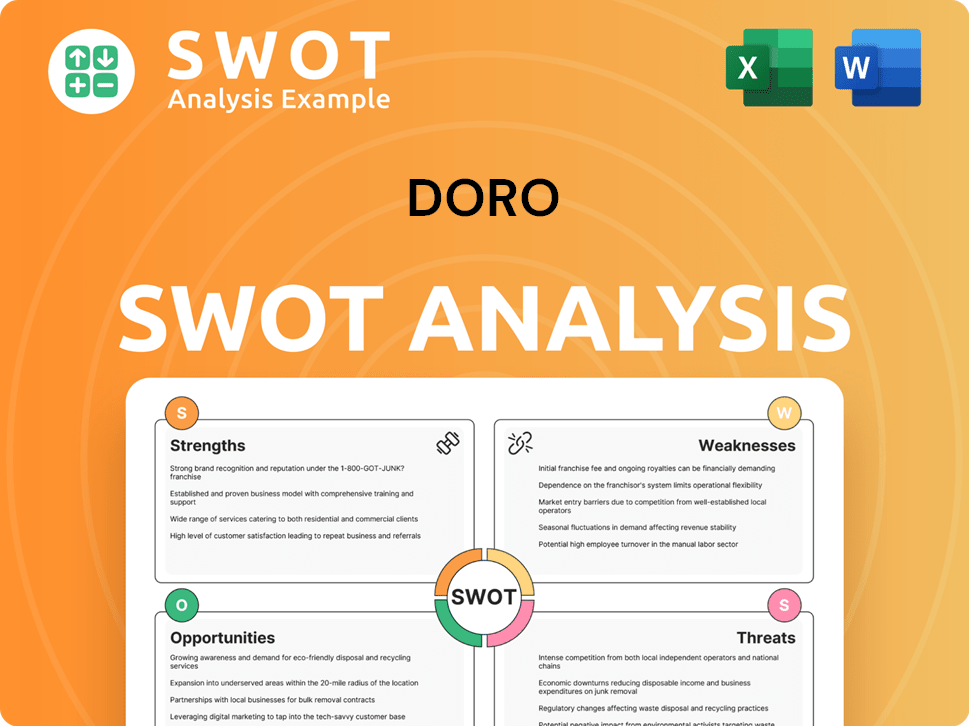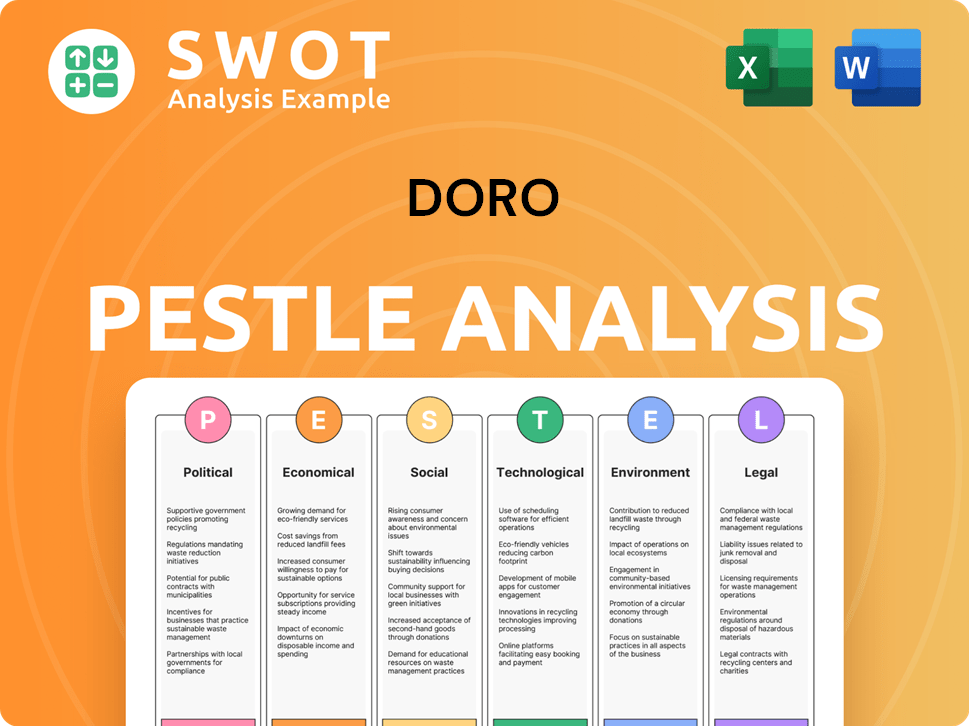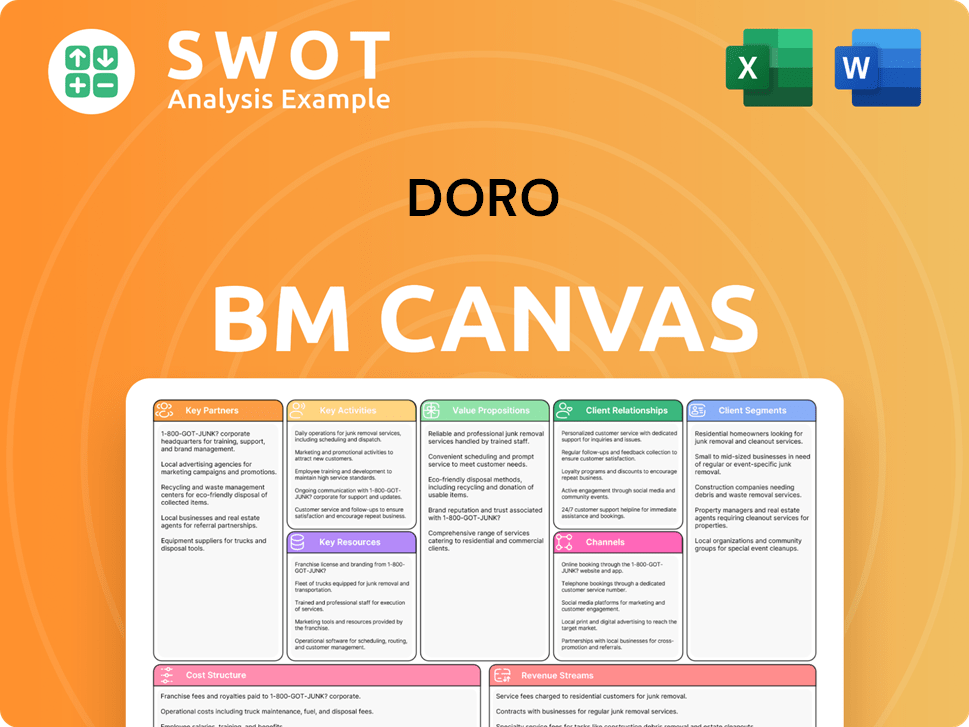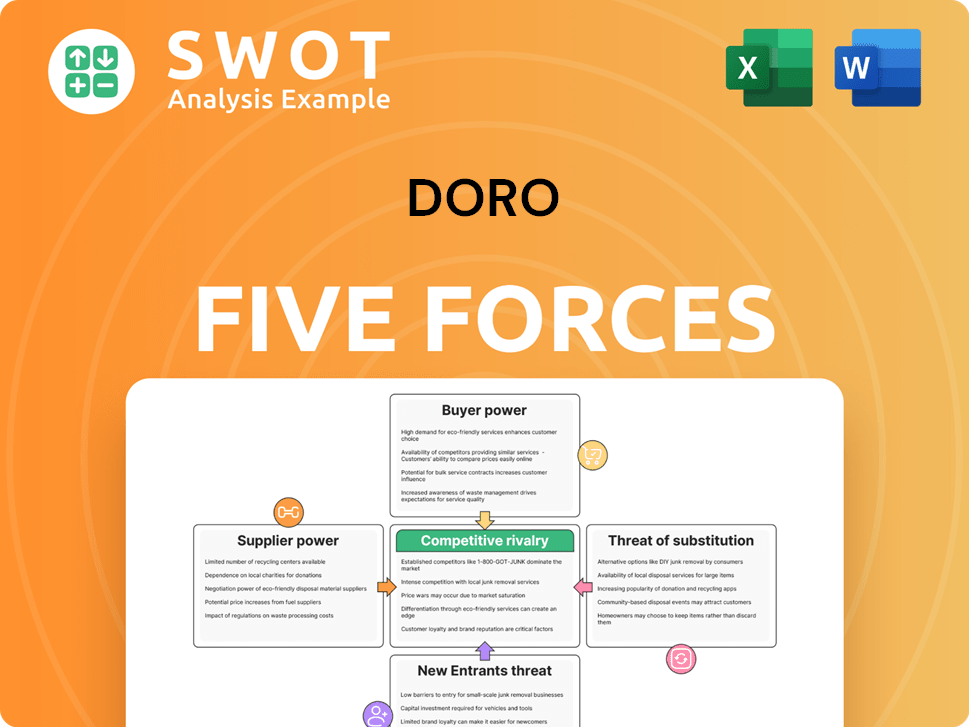Doro Bundle
Can Doro Maintain Its Edge in the Senior Tech Market?
Doro AB has established itself as a leader in senior-friendly technology, but the competitive landscape is constantly shifting. Founded in 1974, Doro has evolved from landline phones to accessible mobile solutions, targeting the unique needs of an aging global population. This Doro SWOT Analysis will provide insights into the company's position.

This Doro company overview will delve into the Doro competitive landscape, providing a detailed Doro market analysis to understand its position. We'll explore Doro competitors and evaluate their strategies, examining the challenges and opportunities Doro faces in the mobile phones for seniors market. Understanding Doro's strengths and weaknesses is crucial for anyone looking to assess its long-term viability in this specialized sector.
Where Does Doro’ Stand in the Current Market?
Doro AB's core operations center around designing and selling telecommunications products and services tailored for seniors. The company focuses on simplifying technology to enhance usability for older adults. Doro's value proposition lies in its commitment to providing accessible, easy-to-use mobile phones and related services that cater specifically to the needs of the aging population.
The company's product range includes feature phones, smartphones, and a suite of services like alarm functions and remote assistance. Doro's market strategy revolves around offering products that prioritize ease of use, safety, and support for seniors. This approach has enabled the company to carve out a distinct niche in the mobile phone market, focusing on a demographic often overlooked by mainstream manufacturers.
Doro's market position is defined by its specialization within the senior-focused telecommunications sector. While specific global market share figures for the senior mobile phone segment fluctuate, Doro has maintained a leadership position in several European markets. For instance, Doro reported net sales of SEK 1,029.3 million for the full year 2023, indicating significant operational scale within its niche. This focus allows Doro to compete effectively against larger, more generalized electronics companies.
Doro is a leader in the senior-friendly technology market. Its specialized focus on ease of use and accessibility has cultivated a strong brand reputation and customer loyalty. This leadership is particularly evident in European markets, where Doro has a considerable presence.
Doro offers a diverse product portfolio that includes feature phones, smartphones, and related services. The company continually innovates to meet the evolving needs of its target demographic. This includes integrating features like emergency call buttons and hearing aid compatibility.
Doro's geographic presence is strongest in Europe, particularly in the Nordic countries, the UK, France, and Germany. These regions have significant aging populations, creating substantial demand for Doro's specialized offerings. The company strategically targets areas with high senior populations.
Doro's financial health is robust within its specialized segment, supported by a clear target demographic and a focused product development strategy. The company's financial performance reflects its strong brand recognition and specialized expertise in the senior care technology sector. Doro's strategic focus on accessibility and customer support further reinforces its standing.
Doro's strengths include its specialized focus, strong brand recognition, and commitment to user-friendly design. The company's market position is enhanced by its ability to adapt to changing market demands and offer a range of products tailored to seniors. Doro's strategic shift towards smartphones demonstrates its ability to meet evolving consumer needs.
- Strong brand reputation among seniors.
- Focus on user-friendly design and accessibility.
- Adaptation to market trends by including smartphones.
- Geographic focus in regions with high senior populations.
Doro SWOT Analysis
- Complete SWOT Breakdown
- Fully Customizable
- Editable in Excel & Word
- Professional Formatting
- Investor-Ready Format

Who Are the Main Competitors Challenging Doro?
The Doro competitive landscape is shaped by a mix of direct and indirect competitors. These rivals vie for market share within the senior-friendly mobile device sector. Understanding these competitors is crucial for a comprehensive Doro market analysis.
Direct competitors focus on similar product offerings, such as simplified mobile phones and smartphones designed for ease of use. Indirect competition comes from mainstream tech companies and mobile network operators, who may offer adaptable devices or alternative solutions for senior connectivity. The dynamics of the market are constantly evolving, with some mainstream companies incorporating senior-friendly features into their standard offerings.
For a deeper understanding of the company's strategic direction, you can explore the Growth Strategy of Doro.
Doro competitors include companies specializing in senior-friendly mobile devices. These firms directly target the same customer base with similar product offerings.
Emporia Telecom, based in Austria, is a direct competitor. They offer simplified mobile phones and smartphones emphasizing ease of use and accessibility features. They compete with Doro through similar product offerings and targeted marketing.
Gigaset, a German company, also competes in this space. While offering a broader range of communication solutions, they provide senior-specific phones with large buttons and clear displays. These companies compete on features, price, and distribution channels.
Indirect competition comes from mainstream smartphone manufacturers and mobile network operators. These companies may not directly target seniors but offer adaptable devices.
Companies like Samsung, Apple, and various Android phone manufacturers offer standard smartphones. These can be adapted for senior use through accessibility settings and third-party apps. They have vast resources and extensive distribution networks.
Mobile network operators often bundle devices with service plans. Some offer their own branded, simplified phones or promote standard devices with enhanced accessibility features. This creates additional competition.
The competitive landscape is dynamic, with shifts in strategies and offerings. Mainstream companies are increasingly incorporating senior-friendly features. This could erode Doro’s niche advantage. The market is also influenced by technological advancements and changing consumer preferences.
- Doro's strengths and weaknesses are key factors in this competition.
- Doro's target audience demographics influence its market positioning.
- Doro's distribution channels play a crucial role in reaching customers.
- Doro's future market strategies will be essential to maintain its position.
Doro PESTLE Analysis
- Covers All 6 PESTLE Categories
- No Research Needed – Save Hours of Work
- Built by Experts, Trusted by Consultants
- Instant Download, Ready to Use
- 100% Editable, Fully Customizable

What Gives Doro a Competitive Edge Over Its Rivals?
Understanding the Doro competitive landscape requires a deep dive into its strengths. The company has carved a niche by focusing on senior-friendly technology, offering products designed specifically for older adults. This specialization, combined with a strong distribution network and dedicated customer support, forms the core of its competitive advantages.
Doro's market analysis reveals a strategic focus on simplicity, ease of use, and safety features in its mobile phones and related devices. This approach has cultivated strong brand loyalty among seniors and their caregivers. By prioritizing the needs of this demographic, Doro has established a sustainable competitive edge in the mobile phone market.
The Doro company overview highlights its commitment to innovation within its niche. Doro continuously adapts to the evolving needs of seniors, ensuring its products remain relevant and user-friendly. This dedication differentiates it from more generalized tech offerings, solidifying its position in the market.
Doro's primary advantage lies in its specialized product development. The company focuses on simplicity, clear audio, and large displays. It also includes essential safety features like emergency call buttons. These features are specifically tailored for seniors.
Doro has cultivated strong brand equity and customer loyalty. This is particularly true among seniors and their caregivers. They value the reliability and ease of use of Doro products. This loyalty is a key factor in Doro's success.
Doro benefits from an established distribution network. This network includes pharmacies, specialized electronics retailers, and healthcare providers. The company effectively reaches its target audience through these channels. This is especially true in European markets.
Doro leverages strategic partnerships with telecare service providers. This further integrates its devices into broader senior care ecosystems. This approach allows Doro to provide integrated solutions beyond just hardware. This enhances the overall value proposition.
Doro's competitive advantages are centered around its deep understanding of the senior demographic. This focus allows it to create products that meet specific needs. Doro's long-term success is tied to its ability to innovate and adapt.
- Specialized Product Focus: Doro specializes in mobile phones for seniors. This focus allows for tailored features.
- Strong Distribution: Doro's distribution network is a key asset. It reaches seniors through trusted channels.
- Customer Support: Dedicated customer support enhances customer satisfaction. This support is often staffed by individuals trained to assist older users.
- Strategic Partnerships: Doro partners with telecare service providers. This integration expands its reach and service offerings.
Doro Business Model Canvas
- Complete 9-Block Business Model Canvas
- Effortlessly Communicate Your Business Strategy
- Investor-Ready BMC Format
- 100% Editable and Customizable
- Clear and Structured Layout

What Industry Trends Are Reshaping Doro’s Competitive Landscape?
The competitive landscape for the company is shaped significantly by industry trends and the evolving needs of its target demographic. The senior-focused technology market is experiencing substantial growth, driven by the aging global population. This demographic shift is increasing the demand for accessible communication devices, health monitoring solutions, and smart home technologies.
Technological advancements, particularly in AI, IoT, and remote health monitoring, present both opportunities and challenges. Staying competitive requires continuous innovation and adaptation to maintain product relevance. Understanding the dynamics of the senior technology market is crucial for assessing the company's position and future prospects.
The aging global population is a primary driver for the senior-friendly technology market. This demographic shift fuels demand for accessible devices and services. Technological advancements in AI, IoT, and remote health monitoring offer new opportunities.
Increased competition from mainstream tech companies is a significant challenge. Regulatory changes in data privacy and accessibility standards impact product development. Continuous investment in R&D is essential to avoid obsolescence in a rapidly changing technological landscape.
Expanding into new geographic markets with aging populations presents growth opportunities. Developing integrated service offerings, such as health monitoring, enhances market appeal. Strategic partnerships with healthcare providers and smart home technology companies can be beneficial.
The company's strategy emphasizes user-centric design and service enhancements. Strategic collaborations are key to maintaining a competitive edge. Adapting to trends while focusing on simplicity and accessibility will be crucial.
To navigate the Brief History of Doro, the company must focus on innovation and strategic partnerships. The senior technology market is projected to continue its growth trajectory, with an increasing number of older adults adopting technology. The company's ability to adapt and innovate will determine its success.
- Focus on user-centric design to meet the specific needs of seniors.
- Explore and integrate advanced technologies like AI and IoT.
- Expand into new markets, particularly those with aging populations.
- Develop partnerships with healthcare providers and technology companies.
Doro Porter's Five Forces Analysis
- Covers All 5 Competitive Forces in Detail
- Structured for Consultants, Students, and Founders
- 100% Editable in Microsoft Word & Excel
- Instant Digital Download – Use Immediately
- Compatible with Mac & PC – Fully Unlocked

Related Blogs
- What are Mission Vision & Core Values of Doro Company?
- What is Growth Strategy and Future Prospects of Doro Company?
- How Does Doro Company Work?
- What is Sales and Marketing Strategy of Doro Company?
- What is Brief History of Doro Company?
- Who Owns Doro Company?
- What is Customer Demographics and Target Market of Doro Company?
Disclaimer
All information, articles, and product details provided on this website are for general informational and educational purposes only. We do not claim any ownership over, nor do we intend to infringe upon, any trademarks, copyrights, logos, brand names, or other intellectual property mentioned or depicted on this site. Such intellectual property remains the property of its respective owners, and any references here are made solely for identification or informational purposes, without implying any affiliation, endorsement, or partnership.
We make no representations or warranties, express or implied, regarding the accuracy, completeness, or suitability of any content or products presented. Nothing on this website should be construed as legal, tax, investment, financial, medical, or other professional advice. In addition, no part of this site—including articles or product references—constitutes a solicitation, recommendation, endorsement, advertisement, or offer to buy or sell any securities, franchises, or other financial instruments, particularly in jurisdictions where such activity would be unlawful.
All content is of a general nature and may not address the specific circumstances of any individual or entity. It is not a substitute for professional advice or services. Any actions you take based on the information provided here are strictly at your own risk. You accept full responsibility for any decisions or outcomes arising from your use of this website and agree to release us from any liability in connection with your use of, or reliance upon, the content or products found herein.